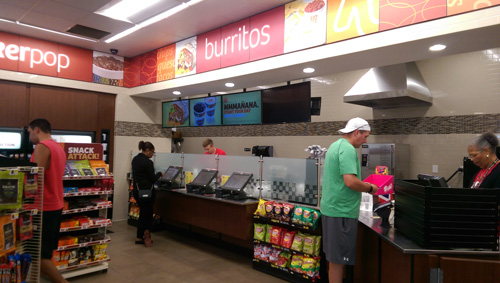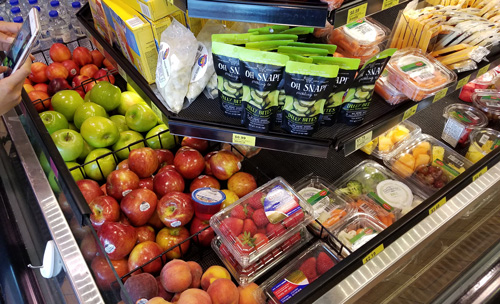By Frank Beard
It’s no secret that convenience retailing faces many potentially disruptive challenges. Jeff Lenard, vice president of strategic industry initiatives at NACS, said it well in a recent podcast with KFGO in North Dakota: “If you aren’t at least as convenient as the internet, you’re in trouble.”
As I’ve visited convenience stores around the country, attended conferences and spoken with industry leaders, I’ve noticed a few things that keep me optimistic. With 2018 approaching, here are three trends that stand out from this year:
1. Consumer-centricity
By embracing innovations in self-service and personalization, today’s leading brands have put consumers in control of their individual retail experiences.
It’s a subtle detail, but it matters. Consider the experience found at many QSRs and coffee shops. You wait either wait in line or sit through unpredictable—and sometimes lengthy—drive-thrus, only to have the experience conducted and facilitated by an employee who functions as a sort of gatekeeper.
Even some big box retailers continue to operate from this perspective. How many of us have walked into a store only to be pestered within seconds—by multiple employees—who ask if they can help us find something?
But when I walk into convenience retailers like Ricker’s, Wawa, QuikTrip and Sheetz, it’s clear that the customer is in control. At Ricker’s, I order customizable Tex-Mex fare via touchscreen, and I make my own coffee using high-quality, automated machines from Franke and Schaerer. Do I want frozen yogurt? It’s self-serve too. Even the design and layout of the store facilitates a self-directed experience.
 It’s fast, it’s convenient and it accommodates individual preferences. While customers do have to wait on an employee to pay for their purchases, that’s a minor detail. The point is that consumers are in charge. Employees simply enhance the experience with customer service as needed.
It’s fast, it’s convenient and it accommodates individual preferences. While customers do have to wait on an employee to pay for their purchases, that’s a minor detail. The point is that consumers are in charge. Employees simply enhance the experience with customer service as needed.
2. Differentiation
In the past, many convenience retailers offered the same basic products with little differentiation. Although some have continued to operate this way, today’s leading stores and brands have set themselves apart with unique offerings—especially in foodservice.
Not only do brands like Sheetz, Rutter’s, and Maverik differentiate themselves this way, but many independent retailers do so as well. The 36 Lyn Refuel Station in Minneapolis, MN offers a wide variety of locally-produced beverages and snacks, and the High Country Market and GastroPub in Round Rock, TX offers wine tastings, unique craft beers, and a range of food with such attention to detail that black truffle oil is used in the homemade ketchup.
Unique offerings matter. The promise of many potentially-disruptive newcomers—such as Bodega and GoPuff—is quicker, more convenient access to packaged beverages, snacks, and small groceries. To get a slice of Casey’s pizza or a Wawa Gobbler, however, you have to visit one of their locations.
As an added convenience, however, Wawa offers does offer delivery via GrubHub in select locations, and Casey’s fans can order pizza delivery through their mobile app.
3. Something for Everyone
As I explained in an upcoming episode of Convenience Matters, providing healthful options isn’t about excluding the indulgent products—but rather offering something for everyone. It’s a way to broaden your customer base. This is especially important since 93% of Americans live less than 10 minutes from a convenience store, and half of Americans already visit them daily.
From what I’ve seen visiting stores around the country, however, 2017 has been a good year for consumers who want healthful, on-the-go options. More often than not, I’m able to find something when I step inside a convenience store—even if it’s as simple as mixed nuts and an apple or banana. In the case of leading retailers like Kwik Trip, the healthful choices are far more plentiful.
 Positive changes are on the horizon as well. Consider HyVee’s new Fast & Fresh convenience store concept. At around 10,000 square feet, these stores will place a significant focus on healthful products—offering both fresh prepared food and table service.
Positive changes are on the horizon as well. Consider HyVee’s new Fast & Fresh convenience store concept. At around 10,000 square feet, these stores will place a significant focus on healthful products—offering both fresh prepared food and table service.
“What we’re trying to do with this concept is meet the needs of those folks who live busy lives,” a company representative told the Pioneer Press.
Frank Beard is a regular NACS Daily contributor who has traveled to more than 1,000 convenience stores in 24 states. He raised awareness of the industry's healthful food options with his "30 Days of Gas Station Food" experiment, and he's an analyst/evangelist for convenience store and retail trends at GasBuddy. Follow Frank on Twitter at @FrankBeard.